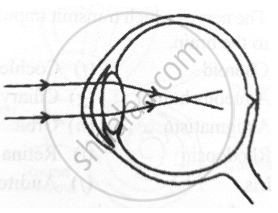Advertisements
Advertisements
Question
Five persons A, B, C, D and E have diabetes, leukaemia, asthma, meningitis and hepatitis, respectively.
Which of these persons can donate eyes?
Solution
Person with asthma (C) can donate his eyes.
APPEARS IN
RELATED QUESTIONS
Fill in the following blank with suitable words:
When light is dim, the pupil becomes................
With reference to the functioning of the eye, answer the question that follow:
Name the two structure in the eye responsible for bringing about the change in the shape of the lens.
Explain the Term: Accommodation in the eye
What is the nature of the image that forms on the retina?
Mention, if the following statement is True or False
Rods are responsible for vision in the dark
Write an Explanation.
Power of accommodation
Complete the paragraph by choosing the right options given below.
(minimum, near point, 25 cm, farthest, farthest distance, far point)
The _______ distance of an object from a normal eye, at which it is clearly visible without stress on the eye, is called the minimum distance of distinct vision. The position of the object at this distance is called the _______ of the eye, for a normal human eye, the near point is at _______. The _______ distance of an object from a human eye, at which it is clearly visible without stress on the eye is called _______ of distinct vision. The position of the object at this distance is called the _______ of the eye.
Given below is a diagram depicting a defect of the human eye. Answer the questions that follow:

- Give the scientific term for the defect.
- Mention one possible reason for the defect.
- What type of lens can be used to correct the defect?
Eyes of the nocturnal birds have large cornea and a large pupil. How does this structure help them?
Match the following.
| Column - I | Column - II | ||
| 1 | Retina | a | Path way of light |
| 2 | Pupil | b | Far point comes closer |
| 3 | Ciliary muscles | c | near point moves away |
| 4 | Myopia | d | screen of the eye |
| 5 | Hypermetropia | e | Power of accomadation |
